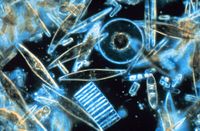
Photo from wikipedia
Growing research interest in the use of diatomaceous biosilica results from its unique properties, such as chemical inertness, biocompatibility, high mechanical and thermal stability, low thermal conductivity, homogeneous porous structure… Click to show full abstract
Growing research interest in the use of diatomaceous biosilica results from its unique properties, such as chemical inertness, biocompatibility, high mechanical and thermal stability, low thermal conductivity, homogeneous porous structure with a large specific surface. Unlike the production of synthetic silica materials with a micro- or nano-scale structure in an expensive conventional manufacturing process, diatomaceous biosilica can be produced in huge quantities without significant expenditure of energy and materials. This fact makes it an unlimited, easily accessible, natural, inexpensive, and renewable material. Moreover, the production of bio-silica is extremely environmentally friendly, as there is essentially no toxic waste, and the process does not require more energy compared to the production of synthetic silica-based materials. For all these reasons, diatoms are an intriguing alternative to synthetic materials in developing cheap biomaterials used in a different branch of industry. In review has been reported the state-of-art of biosilica materials, their characteristics approaches, and possible way of application. This article is protected by copyright. All rights reserved.
Journal Title: Journal of separation science
Year Published: 2022
Link to full text (if available)
Share on Social Media: Sign Up to like & get
recommendations!